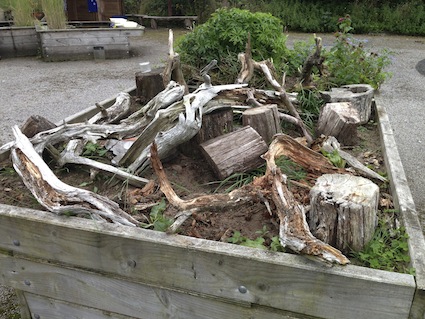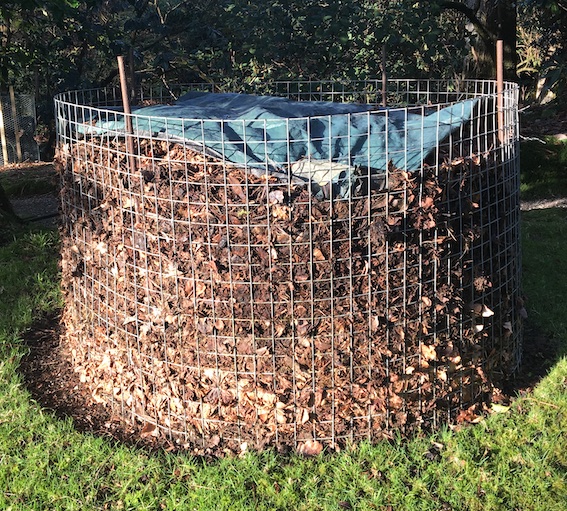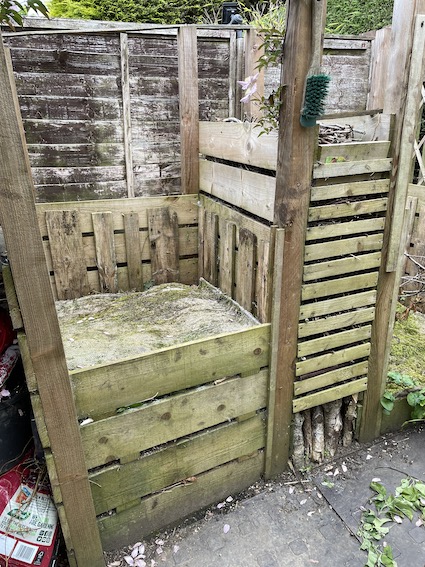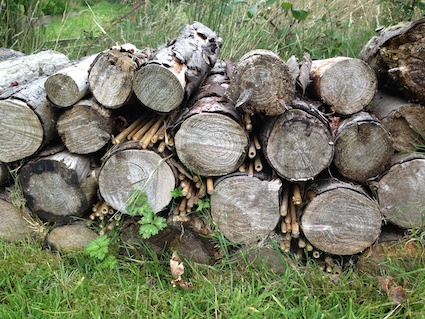
When children go bug hunting, many often want to create homes for minibeasts. Any measures which improve the biodiversity of an outdoor space help. Creating a range of habitats will help attract more creatures into the grounds. In the photo above, this minibeast habitat has been developed on a raised platform, making it wheelchair accessible.
Below are some very simple ideas for classes who are unsure about where to begin.
1. Create a leaf pile.
If you have a quiet corner where the wind doesn’t reach, then an undisturbed pile of leaves can become a home for harvestmen, beetles, mites and other creatures. Ideally, you will eventually have layers that mimic a woodland floor. The top layer is the litter horizon. The leaves should be recognisable. Below this is a second layer where the leaves begin to break down. This is known as the fermenting layer. The leaves will be more compacted and many will be beginning to rot. The third layer, or horizon is the humus. This is dark brown or black as the leaves have completely rotted down. Gardeners often create leaf mould by piling leaves into a mound that is surrounded by chicken wire to hold the leaves in. This is a useful form of compost once it is properly broken down. This can take 2-3 years.

2. Create a rock or stone pile
Rock or stone piles can be created in different places to attract a wide diversity of creatures. If possible, dig a shallow pit and put some large slabs over it so that shelter is available for amphibians such as toads. A range of sizes of rocks can be helpful. Bear in mind, children’s curiosity will mean that they will want to lift up stones and have a look. So place bigger ones in the centre of the pile out of children’s reach. Leave smaller ones around the outside that children can lift and explore. Minibeasts such as some types of spiders like a drier home so seek stones higher up and cracks in walls.
3. Experiment with brash
Small branches, cones and other fallen offerings from native trees will also provide useful homes and habitats for creatures as they rot down. I used to keep a small pile of such material near my compost bin which could not be composted but provide another home for minibeasts. In the photo below you can see it to the right of the compost bin. There’s a 2nd compost bin and this brashing area connects the two.

4. Lay out carpet tiles
One or two carpet tile laid over damp soil can be very attractive for some soil dwellers who like the dark and damp. It is also easy for children to lift up and look. In the above photo, the carpet tile laid on top of the compost heap. This keeps it nice and dark for the creatures – below are worms, slaters, slugs and much more.
5. Let a patch of your playing field grow long grass
Long grass provides a safer home for insects and invertebrates. Wildflowers are given a chance to grow. Before long, quite a few creatures will move in. Just remember to liaise with your local authority and the company which does the grass cutting to ensure that the grass isn’t inadvertently cut.
6. Leave nettles to grow
Nettles are homes for certain types of caterpillars. In a sunny location, they attract insects. They are also good plants to add to compost bins and make nettle soup with.
7. Grow a wildflower mini meadow
There are many native seed mixes available from garden centres and wildlife organisations. A raised bed or patch of bare ground in the open will quickly produce a heap of flowers over the summer months. Plantlife is a helpful organisation for practical advice especially if you want to create a big meadow. Bear in mind, that proper wildflower meadows need specific cutting regimes so consider how you will manage this.
8. Log piles. The more the merrier. This blog post gives you plenty of hints and tips.
Don’t forget to encourage children to label their minibeast habitats so that others realise they are intentional features. Remember to re-visit and enjoy the discovery of new creatures moving in!

Below are some ideas which take a little more work but worthwhile doing…
Minibeast hotels and other residences. This blog post provides information about the wide range of possibilities that exist. However, like ourselves, minibeasts prefer their own natural homes rather than hotels most of the time.
Compost bins are wonderful features that attract slugs, worms and other creatures. Follow the advice in this post for creating one.
Wormeries are very useful. This blog post gives you some hints how to get going. As well as one which breakdown food, it is also easy to create one in a plastic bottle which shows how worms mix up the soil. These can be kept inside.
Ponds are perfect for attracting aquatic minibeasts. Look at this blog post for advice and suggestions.
Plant an orchard. Fruit trees and shrubs attract flying insects that pollinate the flowers that become the fruit we love to eat. Heritage varieties are particularly valuable to preserve the diversity of fruit.
Plant native trees. Native trees have greater biodiversity value. Trees have lots of seeds which get scattered each year. Children can have fun collecting tree seeds that have fallen: acorns, hazel nuts, Scot’s pine cones and holly berries are just a few examples that children can collect and try to grow – be warned some are easier than others. The Woodland Trust operate a free trees for schools scheme too.
Naturally making your grounds more wildlife friendly is helpful – this wildlife garden was created on a shoestring budget. The Wee Green Fingers blog post has lots of ideas for native and wildlife friendly plants.
Remember – any features or habitats your class creates will need to be cared for and maintained. So ensure you have the time and inclination to do this. Look for links to the curriculum so that you can justify the caring and routines as part of your classwork rather than as an extra. No-one has time for extra work.
This post was originally published in April 2016.






























We can’t wait to try this in our garden tomorrow….we’re going to make a mini beast hotel with our log pile! Thanks for sharing! #CountryKids
I hope this goes well. Although minibeast hotels have become trendy, nothing beats the simplicity of an old-fashioned log pile, stone pile or piece of carpet. But it’s very satisfying creating something.
Some great ideas in here for bug homes that anyone could try. There really is something for everyone. I’m very hopeful for our bug hotel which is into its second year this summer, I’m hoping we will have plenty of inhabitants. I had never thought of the orchard as somewhere to look for bugs, but you are right for fruit will attract them. We will have to make an activity hour around bugs in the orchard this September when the apples are at their best. Thank you for sharing with me on CountryKids